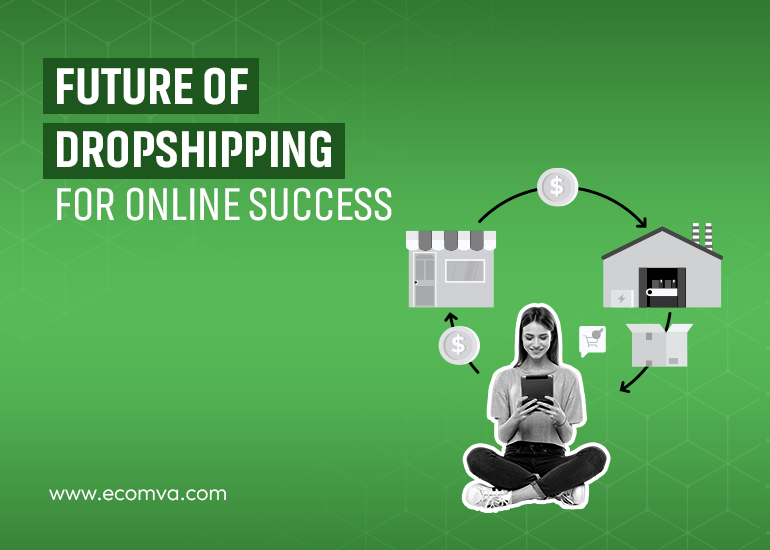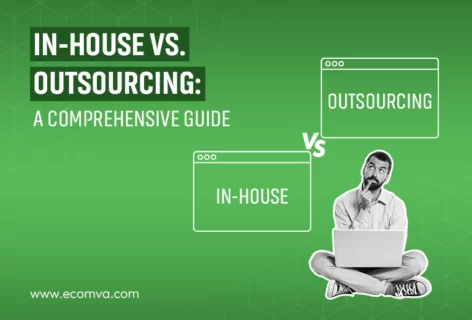Future of E-commerce: Unlock Success with Dropshipping Virtual Assistant

In recent years, the dropshipping virtual assistant model has been adopted by many businesses. For many firms, the e-commerce field calls for constant development, and searching for new ideas has become obligatory. Being free from inventory problems and initial investments, dropshipping trends are one of the most effective ways of retailing, with simple and global possibilities for entrants. In this age where consumers prefer purchasing products online, implementing drop shipping proves to be a powerful tactic for success.
What is meant by a dropshipping business?
When a store uses this method, it does not have to keep stock of what it sells.
Instead, if the store sells something, they buy it from somewhere else before directly sending it to the person who bought the product.
Hence, with this e-commerce innovation, the seller doesn’t come into contact with the product physically.
What are the trends of the dropshipping business?
1. Low Startup Costs
A. Minimal Investment
With dropshipping trends, there is no requirement for large capital investment in inventory and warehousing to stock up products. It is easy to begin with due to the low costs that allow starting an online shop for anyone who wants.
B. Reduced Financial Risk
It is important to note that since the company does not have to purchase stock in advance, the overall financial exposure is low. Companies only acquire materials after an order has been made by a customer.
2. Scalability
A. Easily Scalable Operations
Traditional retail models demand more investments and more efforts to scale up such as hiring more staff or expanding warehouse capacity. Unlike conventional retail stores, dropshipping virtual assistant services are e-commerce innovation that are easier to scale since the supplier manages inventory and shipment.
B. Wide Product Range
A vast number of products can be made available for sale without concerns of warehousing, thus allowing retailers to satisfy obscure segments of demand or experiment in product differentiation with minimal risk.
3. Flexibility and Convenience
A. Location Independence
What good is it to invest in a dropshipping business without remote operation from any place that has access to an internet network? Among the multiple merits of this opportunity, which attracts numerous future entrepreneurs, is the option to be stationed in any part of the world.
B. No Inventory Management
With dropshipping trends, since suppliers manage inventory and delivery of goods, business owners can dedicate their time to selling, customer support, and other value-added tasks.
4. Access to Global Markets
A. International Reach
Dropshipping allows retailers to sell to customers all over the world without the complications that come with cross-border operations, such as shipping and tariffs. This way, suppliers deal with the challenging issue of international shipping.
B. Market Testing
Using virtual goods that reflect local trends, retailers can experiment with various international markets by providing different types of products without necessarily risking a great deal of capital.
5. Leveraging Technology
A. Advanced eCommerce Platforms
Various online platforms offer easy-to-use interfaces and resources that help people run their own dropshipping business; they include Shopify, WooCommerce, and even BigCommerce.
B. Automation Tools
Its compatibility with other automation tools and services enhances the workflow for orders, inventory, and other processes, reducing manual work in most processes.
6. Consumer Trends
A. Increasing Online Shopping
The continued changing of an online platform for buying goods has a critical impact on thriving E-commerce, thanks to the COVID-19 pandemic. This growing demand is met quite well by drop shipping.
B. Customization and Personalization
Customization or personalization of products is almost seamless, satisfying consumers’ growing desire for a tailored shopping experience.
What are the benefits of starting a dropshipping business?
1. Low Startup Costs
A. Minimal Initial Investment
As you don’t require any physical stocks in this type of business, the initial capital is considerably lower than in other conventional stores.
B. Reduced Financial Risk
This e-commerce innovation means that there is no requirement to purchase the stocks previously so in case they do not sell there is a risk of being stuck with them for some time.
2. Easy to Start
A. Simple Business Setup
The process of establishing a dropshipping business is relatively easy, as it only needs an online store and suppliers.
B. No Need for Inventory Management
Suppliers take on the responsibility of storage and management of stocks, as well as their shipment, thus minimizing the complexity of the business.
3. Scalability
A. Flexible Growth
One of the main advantages of the dropshipping model is its ability to easily scale. It also allows you to increase your goods assortment or target new regions without facing the problems of a regular store.
B. Supplier-Managed Logistics
As the orders come through, the load to provide them lies not with the infrastructure but with the suppliers.
4. Wide Product Selection
A. Access to Diverse Products
With virtual inventory management, some of them do not involve you having to carry products as stock meaning that you can offer different products depending on customers’ preferences and trends in the market.
B. Easy Market Testing
It is possible to launch new products with limited financial exposure in the market, which means one can easily respond to consumers’ needs.
5. Operational Flexibility
A. Location Independence
One great thing about a dropshipping virtual assistant is that it is not confined to a specific geographic area and therefore one can run it from any part of the world, like Walmart dropshipping virtual assistant automation.
B. Focus on Core Activities
One major advantage of not having a tangible product to deal with is that you can now focus on other important areas such as marketing and customer service.
6. Reduced Overhead Costs
A. Lower Operational Expenses
They do not incur warehousing, packaging, and shipping expenses, which significantly reduces the overall cost of operations.
B. No Need for a Physical Storefront
Managing a business online eliminates the costs associated with undertaking a physical storefront. It also ensures virtual inventory management of stocks.
7. Enhanced Customer Experience
A. Product Variety
The greater the choice of goods, the more customers will be attracted to your store and the longer they spend there.
B. Quick Adaptation to Trends
It is easy to add new products to the portfolio with the help of Amazon virtual assistant, which enables one to capture new trends within the market or the needs of the consumer.
8. Automation Opportunities
A. Automated Systems
Some of the leading automation features available at eCommerce platforms and solutions include order processing, inventory management, and customer communication.
B. Integration with Suppliers
Automated communication with suppliers can enhance order automation and minimize the number of manual operations and errors.
How to start dropshipping?
If you are thinking about how to automate your dropshipping business, here is the detailed process:
Step 1: Decide on a tendency
A. Research and Identify
Select an area of specialization with the help of a dropshipping virtual assistant that is exciting to you and there is demand in the market. When selecting products, always aim to go for those that address a certain issue or meet a certain need.
B. Evaluate Competition
It can be hard to have a piece of the market share come by where the competition is stiff while on the other hand, the competition can be too low in case the niche is not very popular. Ensure you recognize your competitors in terms of what they offer, their strengths, and weaknesses.
Step 2: Analyze the market
A. Use Tools and Resources
It is also important to look for online tools and digital commerce trends like Google Trends, keyword research tools, and market research reports to know the market demand.
B. Identify Target Audience
Identify your target market and their buying patterns.
Step 3: Locate the Right Vendor
A. Research Suppliers
Hire a dropshipping virtual assistant to select dealers who provide good quality products along with good customer support. Some platforms can be handy when searching for suppliers, including AliExpress, Oberlo, Spocket, and SaleHoo.
B. Evaluate Supplier Reliability
Read online reviews and testimonials from other users, place test orders to test the quality, and consider whether the supplier can accommodate your requirements on shipping and delivery.
Step 4: How to Choose Your Business Type
A. Register Your Business
Select your desired business name and proceed with the registration process, for example, Walmart dropshipping automation. You might be required to register your business as a sole proprietor, LLC, or a corporation as per the laws of your country.
B. Get Necessary Permits
Ensure you acquire all necessary legal permits and licenses for your kind of commerce.
Step 5: Establish an Internet Shop
A. Choose an eCommerce Platform
There are some well-known platforms used by many people who are involved in e-commerce including BigCommerce, Wix, WooCommerce, and Shopify. Pick one digital commerce trend that you think will suit you best and your pocket!
B. Design Your Store
As much as possible, make it a point to avail of store designs that fit the extent of the brand you have in mind. Ensure the layout is friendly enough for the intended user and is well-optimized for any mobile browser to display effectively.
C. Add Products
You can import products from your suppliers with detailed descriptions, high-quality images, and prices.
Step 6: Integrate Payment Solutions
A. Set Up Payment Options
Hire a dropshipping assistant to implement safe payment solutions such as PayPal, Stripe, and other credit card integration services for seamless payment processing.
Step 7: Anticipate the SEO
A. Keyword Optimization
Always incorporate digital commerce trends like sensible keywords in your product descriptions, titles, and meta tags to enhance your store’s search engine visibility.
B. Content Marketing
Create a blog to attract traffic and show your audience that your store is the place to visit in your niche.
Step 8: Launch Your Store
A. Test Everything
It is important to give your store a trial run before going live to check if all components, such as payment systems, orders, etc. are properly integrated. Hire a virtual assistant for this process.
B. Go Live
When everything is ready, go live with your store and start advertising it!
Summing Up!
While the e-commerce industry is growing and experiencing frequent shifts, changes, and new tendencies, dropshipping has turned into a strong and versatile business model.
It is characterized by low entry barriers, flexibility, and ease of operation, which makes it ideal for beginners or veterans in business.
Therefore, by hiring a dropshipping virtual assistant and using the opportunities of dropshipping, companies can provide a wide selection of goods, adjust to trends promptly, and improve the consumer experience.
With the increasing adoption of technology and globalization, dropshipping will be among the important factors that will define the future of the international e-commerce industry and provide room for success despite the higher level of competition existing in the market.











